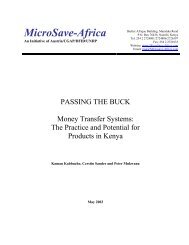Create successful ePaper yourself
Turn your PDF publications into a flip-book with our unique Google optimized e-Paper software.
<strong>DAI</strong> worked in the<br />
Caribbean and<br />
elsewhere to help<br />
economies diversify<br />
from rural agriculture<br />
into the production <strong>of</strong><br />
exportable goods.<br />
36<br />
vention in Grenada in 1983. Originally, HIAMP<br />
was an unusually experimental and innovative<br />
project that aimed to bring U.S. agribusiness<br />
expertise and deal-making techniques to the<br />
very small island economies <strong>of</strong> Barbados, Grenada,<br />
and their West Indian neighbors.<br />
Mickelwait had participated in the design <strong>of</strong><br />
HIAMP, along with Don Humpal, who recalls<br />
“it was very complex, and Don [Mickelwait]<br />
probably understood it better than many <strong>of</strong> our<br />
clients and local counterparts.” This distinction<br />
cut both ways: it helped <strong>DAI</strong> prepare a winning<br />
proposal, but it also meant that HIAMP was perceived<br />
as a risky venture by many <strong>of</strong> its stakeholders.<br />
The project goal was to empower local<br />
entrepreneurs to move the economy beyond<br />
tourism, bananas, and sugar cane to high-value<br />
export products. Although <strong>DAI</strong>’s team identified<br />
many promising opportunities—encompassing<br />
28 subprojects across seven island states—<br />
most <strong>of</strong> the prospective local investors proved<br />
risk-averse, and personnel and policy changes<br />
in USAID’s regional agriculture <strong>of</strong>fice resulted<br />
in restrictive directives that frustrated the field<br />
team, as well as Humpal and Mickelwait. Four<br />
<strong>years</strong> after it started, the leaders <strong>of</strong> the original<br />
<strong>DAI</strong> team were gone, and HIAMP lost its<br />
entrepreneurial edge, with most <strong>of</strong> its activities<br />
scaled back to a more traditional technical assistance<br />
model.<br />
In other countries, however, <strong>DAI</strong> demonstrated<br />
greater persuasiveness and staying power<br />
when it brought new ideas to the client’s table.<br />
In Indonesia, Bill Fuller—after many <strong>years</strong> in<br />
Asia with the Ford Foundation—had arrived in<br />
1982 as a noncareer USAID mission director.<br />
He encouraged innovation by his own staff and<br />
the organizations that supported the country<br />
program. Among the new initiatives was the<br />
Central Java Enterprise Development Project<br />
(CJEDP), whose design would involve in-depth<br />
analysis <strong>of</strong> leading subsectors in the provincial<br />
economy. This challenging task appealed to<br />
Mickelwait, who threw his energies into writing a<br />
successful proposal for the two-year project design<br />
contract. Gary Kilmer was named CJEDP’s<br />
Chief <strong>of</strong> Party, and he found himself interacting<br />
closely with Fuller’s highly engaged team at<br />
USAID, which demanded a rigorous analytical<br />
approach to this novel project. Kilmer recalls,<br />
“They needed convincing that their ideas would<br />
really work in practice.” Among those initially on<br />
USAID’s side <strong>of</strong> this exercise was Jim Boomgard,<br />
a young academic who had been trained



